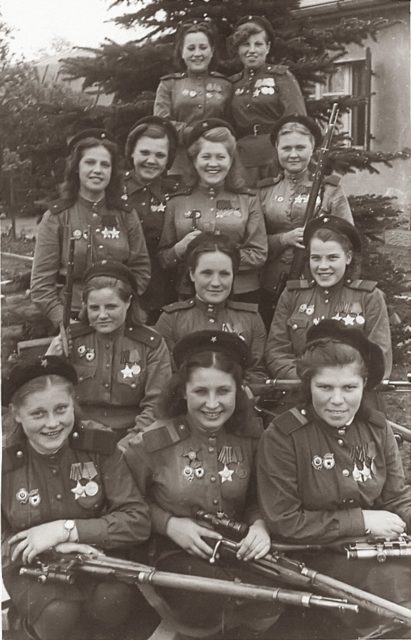During World War II, the Soviet Union suffered from a dearth of manpower because of the terrible casualties on the Eastern Front. In response, 7.75 million women were recruited for industry and the military. 800,000 of these served in the armed forces. 2,000 were snipers. In fact, the Soviet Union was the only belligerent country to recruit female snipers.

The term ‘to snipe’ and ‘sniper’ comes from the 1770s, when the British in India found hunting the Common Snipe challenging. The bird was well camouflaged and flew erratically. So ‘to go on a snipe hunt’ meant to undertake a nearly impossible task requiring great precision. Female Soviet snipers have been credited with 12,000 confirmed kills, and so they could be said to have been successful in their task. Indeed, the Soviet military believed women made excellent snipers, since they tended to be patient, deliberate and careful.
They also avoided hand to hand combat. Major General Morozov said of female snipers “a woman’s hand is more sensitive than is a man’s. Therefore when a woman is shooting, her index finger pulls the trigger more smoothly and purposefully.”
Female soldiers were also trained in infiltration, surveillance, reconnaissance, camouflage and target location skills. They used the Mosin-Nagant 1891 rifle with an optical PU Scope. It fired 7.62×54 cartridges, armor piercing B-30s, tracer bullets or P3 calibrated incendiaries.
Soviet snipers were most successful during the defensive stage of the war with Germany (1941 – 1943). They targeted experienced officers and field commanders, which could prove difficult to replace. When the Soviets became the attackers, German snipers became more deadly.
One sniper, the Ukrainian Lyudmila Pavlichenko, nicknamed ‘Lady Death’, killed over 300 soldiers. Pavlichenko volunteered for service in June 1941. She was 24 years old and had been studying history at Kiev University. She requested to join the infantry and was assigned to the 25th Rifle Division. She later said that “I joined the army when women were not yet accepted.”
Pavlichenko made her first two kills near Belyayevka in the Odessa region and went on to record 187 kills. After about two and a half months, she went to Sebastopol in the Crimea, and remained there some eight months. In May 1942, she was promoted to lieutenant and officially credited for taking out 257 enemy soldiers. In June she was wounded by mortar fire. She returned to combat a few weeks later. By this time she had killed 309 Axis troops, 36 of which were snipers themselves.

Later, in 1942, she was sent to the United States and Canada to promote the war effort. She was the first Soviet citizen to be received by a US president.
Franklin and Eleanor Roosevelt welcomed her to the White House. The First Lady invited Pavlichenko to tour the United States and give talks.
Her tour was generally well-received, but she was surprised by the sorts of questions she was asked by journalists, relating to the femininity of her uniform. In Chicago she appeared before large crowds, urging men to support the Russian war effort. “Gentlemen,” she said, “I am 25 years old and I have killed 309 fascist occupants by now. Don’t you think, gentlemen, that you have been hiding behind my back for too long?” The remark was received with at first shock and then thunderous applause.
In November 1942, Pavlichenko visited Coventry in the United Kingdom. She accepted £4,516 from the workers of Coventry, mostly from the Standard Car Factory, for three X-ray units for the Soviet Army. She viwed the ruins of Coventry cathedral, a Birmingham factory, and the Alfred Herbert works.

When she returned to Russia, she was promoted to Major and trained snipers until the war’s end. She was awarded the Gold Star of the Hero of the Soviet Union in 1943. In that same year, a postage stamp featuring her was issued. The second stamp with her portrait was issued in 1976.
When the war ended, she completed her studies at Kiev University and became a historian. She was a Research Assistant to the Soviet Navy HQ from 1945 – 1953 and later served on the Soviet Committee of the Veterans of War. She died on October 10, 1974. She was 58. Her remains are buried in the Novodevichye Cemetery in Moscow.
